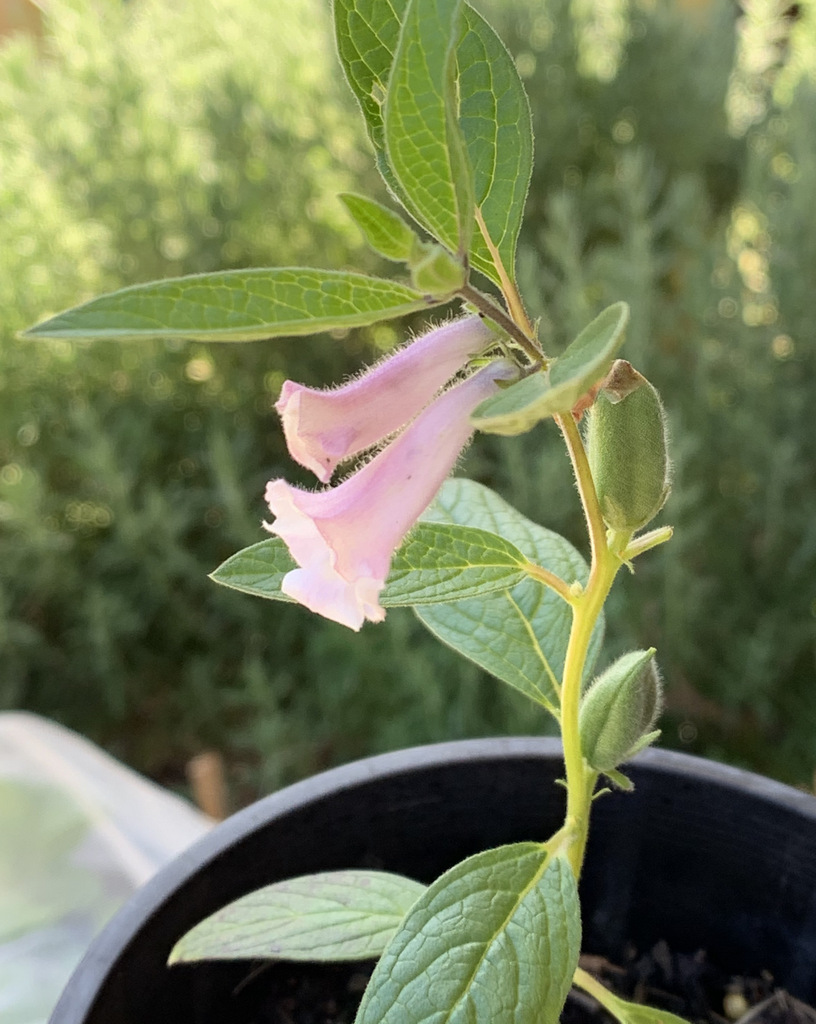The sesame plant is a beautiful ornamental cultivated for its edible seeds that have a range of uses from the kitchen to the cocktail bar. Here’s how to grow a sesame plant from seed.

Sesame Plant – Photo © The Gourmantic Garden
Last summer I tried a little experiment. I planted four black sesame seeds from a packet of seed I had in the pantry for years. They were way past their due date. Much to my surprise, they germinated and seedlings formed. I thinned them out and kept the strongest one.
I transplanted the seedling into a 15cm pot and the little plant formed beautiful trumpet shaped flowers. Over time, the flowers turned into green pods which gradually grew in size. To my surprise again, the plant survived well into mid-winter until a sudden cold spell virtually killed it overnight. The leaves shrivelled and dropped, the seed pods became dry and cracks formed. And you guessed it, it was time for… open sesame!
Difference between White and Black Sesame Seeds
White sesame seeds start as black sesame seeds and have their hulls removed which leaves the white part within. The black seeds have their hulls still intact. When it comes to flavour, the latter have a more pronounced nutty flavour and are slightly more earthy while the former are milder in flavour.
GROW IT
How to Grow Sesame Plant
Sesame, sesamum indicum is a beautiful plant to have in the edible garden. The annual herb thrives in the heat and can be sown directly in ground or raised as a seedling which is my preferred method.
In Sydney’s temperate climate, sow the seeds in late spring/early summer at a depth about twice the size of the seed. Sesame likes full sun so choose a spot in the garden with plenty of sunshine and well drained soil. Germination takes place in 10-14 days and once the first true leaves form, it can be transplanted into the ground or a larger container. If you’re growing more than one in the ground or a raised bed, space the plants 60cm apart.
Sesame Plant Care

Sesame Pods – Photo © The Gourmantic Garden
The plant needs little care. It favours moist and well draining soil. Once established, it can tolerate drought and can thrive in high temperatures with little water. Eventually, pink or white flowers will form and turn into elongated seed pods which mature, turn brown and split open to reveal the seeds.
Sesame plant can grow up to 1.5m tall but in my experiment, I was able to grow it and harvest seed from a tiny plant grown in a 15cm diameter pot and a 10cm tall plant from expired store-bought seed. This season, I’m sowing more seeds with the aim of growing much larger plants.
Harvesting & Seed Saving

Sesame Pod and Seeds – Photo © The Gourmantic Garden
Once the green pods dry and turn brown, they will begin to split. Gently cut the pods with sharp secateurs and carefully harvest the seeds.
Tips for Growing Sesame
- As this is a heat loving plant, it’s best to start sowing once the temperature is consistently warm.
- If growing it in a container, give the plant ample space to grow and don’t follow my experiment using a small pot.
- When the seed pods are mature, they’re very delicate. Exercise care when picking them to avoid seed loss.
EAT IT
Culinary Uses of Sesame
Sesame is used in a range of cuisines from all over the world. Black sesame seeds are commonly used in Asian food, adding a nutty and slightly earthy flavour. Seeds are used to make tahini paste, a key ingredient in Middle Eastern hummus. Toasted seeds can be infused in oil to flavour dishes or in fat washing spirits.
DRINK IT
Sesame in Cocktails
In cocktails, sesame seeds – black, white or a combination of both – can be used to rim a glass. Simply run lemon or lime around the rim of a glass and dip it in the mix.
Sesame can be turned into a syrup. Start by toasting the seeds in the oven to release the nuttiness and flavour. This should take around 10 minutes at 180oC, add it to equal parts water and white granulated sugar, boil and simmer for 10 minutes before straining and bottling.
Infuse the seeds in oil at a very low temperature to add a nutty flavour and to fat wash spirits such as bourbon in an old fashioned cocktail.
SESAME GROWING GUIDE AT A GLANCE
For temperate climate (Sydney, Australia)
- Sowing Season: late spring to summer
- Sowing Method: sow direct or raise seedlings
- Position: full sun
- Seed Preparation: nil
- Soil: well drained moist soil
- Sowing Depth: 4mm
- Plant Spacing: 60cm
- Row Spacing: 60cm
- Plant Height: 150cm
- Germination: 10-14 days
- Time to Maturity/Harvest: 90 to 150 days
- Water Requirements: drought tolerant once established
- Fertiliser Requirements: regular fortnightly liquid fertiliser once established
- Companion Planting: n/a
- Ones to Avoid: n/a
- Succession Planting: n/a
You may also like… How to Grow Olive Herb

